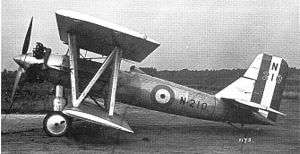Avro Avocet
The Avro Type 584 Avocet was a British single-engined naval fighter prototype, designed and built by Avro. While the Avocet was not built in numbers, one of the prototypes was used as a seaplane trainer for the Royal Air Force's (RAF) High Speed Flight.
| Avocet | |
|---|---|
 | |
| Role | Fighter |
| Manufacturer | Avro |
| Designer | Roy Chadwick |
| First flight | December 1927 |
| Status | Prototype |
| Primary user | Royal Air Force |
| Number built | Two |
Design and development
The Avro 584 Avocet was designed by Avro's chief designer, Roy Chadwick to meet the requirements of Specification 17/25 for a Naval fighter.[1] It was a single-engined, all-metal biplane, powered by a 230 hp Armstrong Siddeley Lynx engine, having interchangeable wheels and floats. Although it did not have folding wings, it was designed to be easily dismantled for storage onboard ship.
Two prototypes were built, the first flying as a landplane in December 1927 and the second prototype flying as a seaplane in April 1928.[1] Both prototypes were evaluated for the Fleet Air Arm at RAF Martlesham Heath, where, owing to the low-powered engine, their performance was seen to be unimpressive,[2] and it was not ordered into production.
Operational history
Although no production occurred, the second prototype was used by the RAF's High Speed Flight at Calshot as a seaplane trainer for Schneider Trophy pilots.[2]
Specifications (Avocet (Wheeled undercarriage))
Data from The British Fighter since 1912 [1]
General characteristics
- Crew: 1
- Length: 24 ft 6 in (7.47 m)
- Wingspan: 29 ft 0 in (8.84 m)
- Height: 11 ft 8.375 in (3.56553 m)
- Wing area: 308 sq ft (28.6 m2)
- Empty weight: 1,612 lb (731 kg)
- Gross weight: 2,495 lb (1,132 kg)
- Powerplant: 1 × Armstrong Siddeley Lynx IV 7-cylinder air-cooled radial piston engine, 230 hp (170 kW)
- Propellers: 2-bladed fixed-pitch propeller
Performance
- Maximum speed: 133 mph (214 km/h, 116 kn)
- Service ceiling: 23,000 ft (7,000 m)
- Wing loading: 8.1 lb/sq ft (40 kg/m2)
- Power/mass: 0.092 hp/lb (0.151 kW/kg)
Armament
- Guns: 2 × fixed .303 in (7.7 mm) Vickers machine guns
References
- Mason, Francis K (1992). The British Fighter since 1912. Naval Institute Press. ISBN 1-55750-082-7.
- Jackson, A J (1990). Avro Aircraft since 1908 (2nd ed.). London: Putnam Aeronautical Books. ISBN 0-85177-834-8.
External links
| Wikimedia Commons has media related to Avro Avocet. |
- Avro Avocet – British Aircraft Directory